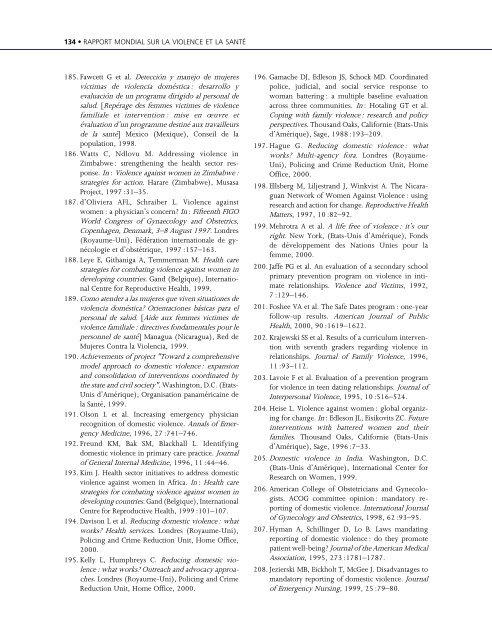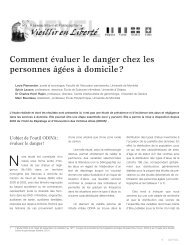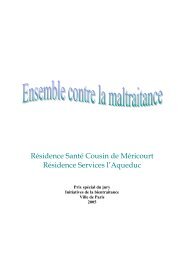Rapport mondial sur la violence et la santé
Rapport mondial sur la violence et la santé
Rapport mondial sur la violence et la santé
You also want an ePaper? Increase the reach of your titles
YUMPU automatically turns print PDFs into web optimized ePapers that Google loves.
134 . RAPPORT MONDIAL SUR LA VIOLENCE ET LA SANTÉ185. Fawc<strong>et</strong>t G <strong>et</strong> al. D<strong>et</strong>ección y manejo de mujeresvíctimas de violencia doméstica : desarrollo yevaluación de un programa dirigido al personal desalud. [Repérage des femmes victimes de <strong>violence</strong>familiale <strong>et</strong> intervention : mise en œuvre <strong>et</strong>évaluation d’un programme destiné aux travailleursde <strong>la</strong> santé] Mexico (Mexique), Conseil de <strong>la</strong>popu<strong>la</strong>tion, 1998.186. Watts C, Ndlovu M. Addressing <strong>violence</strong> inZimbabwe : strengthening the health sector response.In : Violence against women in Zimbabwe :strategies for action. Harare (Zimbabwe), MusasaProject, 1997 :31–35.187. d’Oliviera AFL, Schraiber L. Violence againstwomen : a physician’s concern? In : Fifteenth FIGOWorld Congress of Gynaecology and Obst<strong>et</strong>rics,Copenhagen, Denmark, 3–8 August 1997. Londres(Royaume-Uni), Fédération internationale de gynécologie<strong>et</strong> d’obstétrique, 1997 :157–163.188. Leye E, Githaniga A, Temmerman M. Health carestrategies for combating <strong>violence</strong> against women indeveloping countries. Gand (Belgique), InternationalCentre for Reproductive Health, 1999.189. Como atender a <strong>la</strong>s mujeres que viven situationes deviolencia doméstica? Orientaciones básicas para elpersonal de salud. [Aide aux femmes victimes de<strong>violence</strong> familiale : directives fondamentales pour lepersonnel de santé] Managua (Nicaragua), Red deMujeres Contra <strong>la</strong> Violencia, 1999.190. Achievements of project "Toward a comprehensivemodel approach to domestic <strong>violence</strong> : expansionand consolidation of interventions coordinated bythe state and civil soci<strong>et</strong>y". Washington, D.C. (Etats-Unis d’Amérique), Organisation panaméricaine de<strong>la</strong> Santé, 1999.191. Olson L <strong>et</strong> al. Increasing emergency physicianrecognition of domestic <strong>violence</strong>. Annals of EmergencyMedicine, 1996, 27 :741–746.192. Freund KM, Bak SM, B<strong>la</strong>ckhall L. Identifyingdomestic <strong>violence</strong> in primary care practice. Journalof General Internal Medicine, 1996, 11 :44–46.193. Kim J. Health sector initiatives to address domestic<strong>violence</strong> against women in Africa. In : Health carestrategies for combating <strong>violence</strong> against women indeveloping countries. Gand (Belgique), InternationalCentre for Reproductive Health, 1999 :101–107.194. Davison L <strong>et</strong> al. Reducing domestic <strong>violence</strong> : whatworks? Health services. Londres (Royaume-Uni),Policing and Crime Reduction Unit, Home Office,2000.195. Kelly L, Humphreys C. Reducing domestic <strong>violence</strong>: what works? Outreach and advocacy approaches.Londres (Royaume-Uni), Policing and CrimeReduction Unit, Home Office, 2000.196. Gamache DJ, Edleson JS, Schock MD. Coordinatedpolice, judicial, and social service response towoman battering : a multiple baseline evaluationacross three communities. In : Hotaling GT <strong>et</strong> al.Coping with family <strong>violence</strong> : research and policyperspectives. Thousand Oaks, Californie (Etats-Unisd’Amérique), Sage, 1988 :193–209.197. Hague G. Reducing domestic <strong>violence</strong> : whatworks? Multi-agency fora. Londres (Royaume-Uni), Policing and Crime Reduction Unit, HomeOffice, 2000.198. Ellsberg M, Liljestrand J, Winkvist A. The NicaraguanN<strong>et</strong>work of Women Against Violence : usingresearch and action for change. Reproductive HealthMatters, 1997, 10 :82–92.199. Mehrotra A <strong>et</strong> al. A life free of <strong>violence</strong> : it’s ourright. New York, (Etats-Unis d’Amérique), Fondsde développement des Nations Unies pour <strong>la</strong>femme, 2000.200. Jaffe PG <strong>et</strong> al. An evaluation of a secondary schoolprimary prevention program on <strong>violence</strong> in intimatere<strong>la</strong>tionships. Violence and Victims, 1992,7 :129–146.201. Foshee VA <strong>et</strong> al. The Safe Dates program : one-yearfollow-up results. American Journal of PublicHealth, 2000, 90 :1619–1622.202. Krajewski SS <strong>et</strong> al. Results of a curriculum interventionwith seventh graders regarding <strong>violence</strong> inre<strong>la</strong>tionships. Journal of Family Violence, 1996,11 :93–112.203. Lavoie F <strong>et</strong> al. Evaluation of a prevention programfor <strong>violence</strong> in teen dating re<strong>la</strong>tionships. Journal ofInterpersonal Violence, 1995, 10 :516–524.204. Heise L. Violence against women : global organizingfor change. In : Edleson JL, Eisikovits ZC. Futureinterventions with battered women and theirfamilies. Thousand Oaks, Californie (Etats-Unisd’Amérique), Sage, 1996 :7–33.205. Domestic <strong>violence</strong> in India. Washington, D.C.(Etats-Unis d’Amérique), International Center forResearch on Women, 1999.206. American College of Obst<strong>et</strong>ricians and Gynecologists.ACOG committee opinion : mandatory reportingof domestic <strong>violence</strong>. International Journalof Gynecology and Obst<strong>et</strong>rics, 1998, 62 :93–95.207. Hyman A, Schillinger D, Lo B. Laws mandatingreporting of domestic <strong>violence</strong> : do they promotepatient well-being? Journal of the American MedicalAssociation, 1995, 273 :1781–1787.208. Jezierski MB, Eickholt T, McGee J. Disadvantages tomandatory reporting of domestic <strong>violence</strong>. Journalof Emergency Nursing, 1999, 25 :79–80.









